A Salute To Those Wild & Wooly, Wheelstanding, Gear-Banging, Gassers!
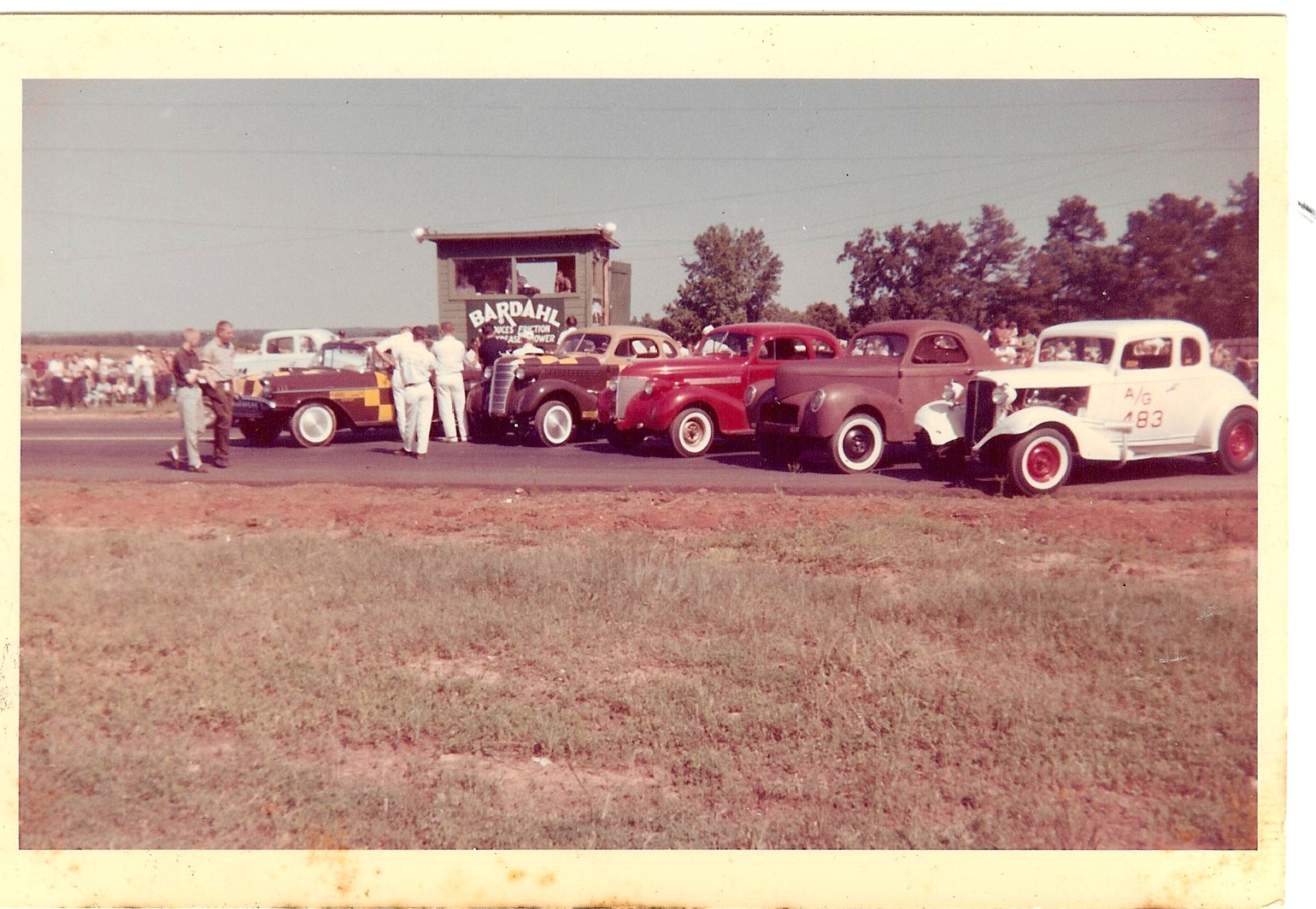
LEADING PHOTO: Here’s the line-up for Little Eliminator with all the Gassers ready to go. Legendary Hubert Platt had far-left ’57 Chevy and ’38 Chevy in the show. Left to right are ’39 Chevy, ’41 Willys and ’33 Chevy, all examples of late 1950’s Gassers.
Story by Jim Hill
The growing popularity of nostalgia drag racing has attracted both new and grizzled fans and racers who really loved the “Gassers” of drag racing in the 1950’s, 60’s and 70’s.
This brings about the question of what exactly is a “Gasser”? Over the years the term has become somewhat blurred. Gassers were as much a part of the culture of drag racing as a racing class, and the classic tales of Gasser heroes define much of drag racing during the 1950’s, 60’s and 70’s.
So, what is a “Gasser”?

Anniston, Alabama’s Billy Holt ran this B/Gas Supercharged ’41 Willys throughout the south. An ECDT Hall of Fame member, Billy Holt later ran successful alcohol Funny Cars.
For high school or college football players the term “gasser” is undoubtedly negative. Coaches often assigned “gassers” as all-out training drills to build speed, stamina, wind and sometimes, discipline. These were universally dreaded by players. Popular music had its own definition of “gasser” as well. Remember Mick Jagger and the 1966 Rolling Stones pounding out: “Jumpin’ Jack Flash He’s a Gas, Gas, Gas”? Finally, your flatulent Uncle Harold’s digestive problems with “gassy” food could also define the term. Fortunately, none of these terms apply here.
For drag racers and drag racing fans, “Gasser” is a term more closely related to the age of the person pondering it. To “baby boomers” the mental imagery might involve a sparkling, candy-apple Willys, ’32 Ford or a ’55 Chevy. For “thirty or forty-somethings” Gasser might mean a ’67 Camaro or early Mustang.
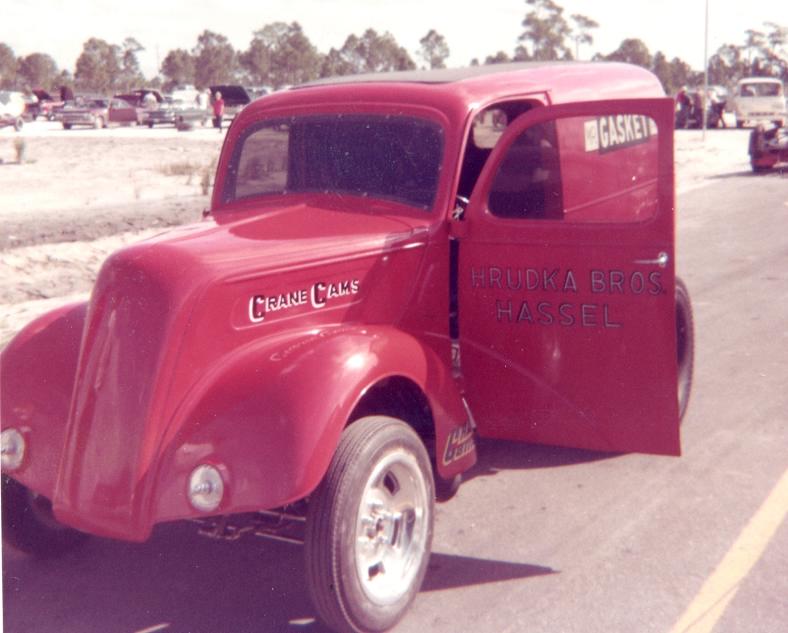
One of the original members of “The Ohio Gassers”, Ron Hassel teamed up with Mr. Gasket founders Joe and Tom Hrudka to run this mid-nine second, 140 mph, A/Gas ’48 Thames “Pie Wagon”. This 1965 shot was at Palm Beach Intl., Raceway. (Jim Hill photo)
By virtue of their birth date, “twenty-somethings” were deprived of ever seeing Gassers competing. As such, their assumed interpretation might involve a Tri-Five Chevy with a high and mighty, straight-axle front-end, and an open-headers, dual four-barreled, V-8.
It matters not what your idea of a “Gasser” may be. What truly matters is that you are a fan of these full-bodied coupes and sedans that through three decades established themselves as icons of the hot rod culture.
Many of the honored members of the East Coast Drag Times Hall of Fame, since its creation, began their drag racing careers in the Gasser ranks. Some stayed loyal to these full-fendered, all-out race cars while others moved up the ladder to race in the ultimate classes of Top Fuel, Funny Car and Pro Stock. all who started out in the Gasser or Modified Production ranks fondly recall how tightly competitive they were.
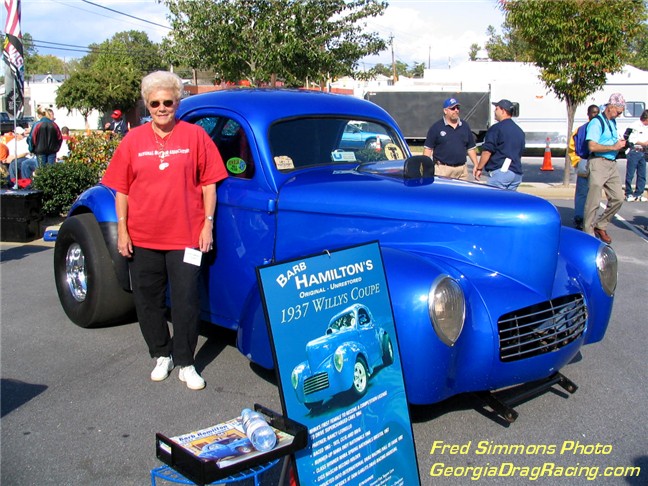
The “First Lady of Gassers” is Barbara Hamilton. Barb was first NHRA licensed female driver of supercharged race car and ECDT Hall of Fame member. Her ’41 Willys is powered by a 6-71 blown small-block Chevy. Show car quality Willys is exactly as raced in the 1960’s!
The term “Gasser” was described a category of race car as outlined by the NHRA (National Hot Rod Assn.) and AHRA (American Hot Rod Assn.) official rule books. Both NHRA and AHRA defined them not as “Gassers”, but “Gas Coupes and Sedans”. IHRA, which came into existence in the 1970’s as the third sanctioning body, also had Gassers and Modified Productions, but called them “Hot Rod” classes. All three had interchangeable class rules making it possible to run without major modifications.
The “Coupes and Sedans” part of the definition is obvious. The “Gas” terminology stated that these cars were not allowed to use anything other than pump-available gasoline for fuel. Of course some Gasser racers did try illegal fuels or additives in hopes of increasing horsepower. But most abided by the rules, or at least the “spirit” of the rules.

Anderson, SC’s Gene Cromer ran this ’41 Willys with 427 FE Ford power, then switched to an SOHC 427 Ford for A/Gas. Gene is an ECDT Hall of Fame member.
It should also be noted that racers were also known to sometimes “re-interpret” those “between the lines” sections of the rule books. Such thinking has always been a part of motorsports, and “getting’ competitive” by sometimes devious means has been a time honored art among racers.
Legendary NASCAR driver and car builder Junior Johnson was known to “interpret” the rule book in his own way, in the process finding its most generous loopholes. Junior once said: “When the tech inspectors are lookin’ at the front end, we’re busy workin’ on the back end!” Serious Gasser drag racers did likewise.
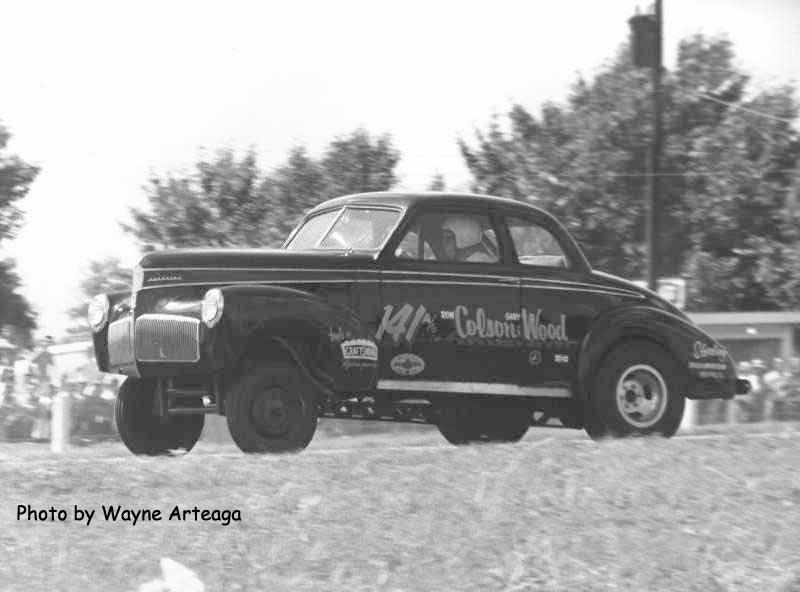
Ron Colson’s first fast ride was this Chevy powered ’41 Studebaker. Colson’s career spanned four decades and included driving Top Fuel dragsters and nitro Funny Cars such as Roland Leong’s “Hawaiian” and “The Chi Town Hustler”.
Generally speaking, coupes or two-door cars were favored over four-doors. Curb-appeal was a key factor. Four-door cars usually weighed more. Coupes (single bench seat or a pair of bucket seats being the only seating accommodations available) were often lighter than two-door sedans and lighter usually means faster. This was easily assimilated in the early days, when there were just four Gas Classes, but less so when the sanctioning bodies started adding classes. This brought about more use of sedans, for the “lower” Gas classes. In the lower classes the added weight of more steel, glass and seats became asset.
In the beginning, Gas Coupe and Sedan classes were created to provide a place for the classic “dual purpose” hot rods to compete. “Dual purpose” meant cars with bolt-on speed equipment, often street driven and licensed. Early Gassers were often driven to the local drag strip, and many were also involved in illegal street racing.
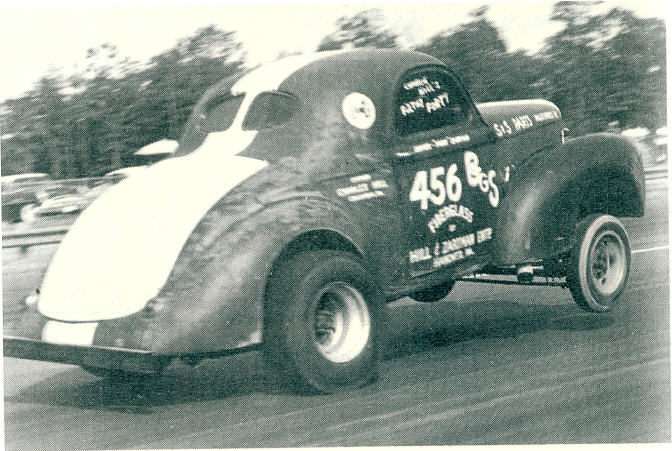
Charlie Hill’s legendary “Filthy Forty” Willys held a national reputation as a C/Gasser, and later with a 6-71 blown Chevy, in B/Gas Supercharged. The late Pork Zartman drove.
A mention of the politics of early hot rodding should be noted. In those days only a few purpose-built drag strips existed. Most sanctioned, organized drag racing happened on abandoned airport runways. When no track was available racers ran illegally, on public streets and roadways. This always caused friction among local residents and of course, the local police.
Early drag racers also had a seriously negative “image issue”. 1950’s Hollywood “B” films often portrayed hot rodders as wild, invading savages, eager to rape, pillage and plunder! The stereotype hot rodder was a greasy thug with a black leather jacket, jeans and assault boots. This left parents and city elders alarmed that the plague might infect their sons or worse, their daughters.
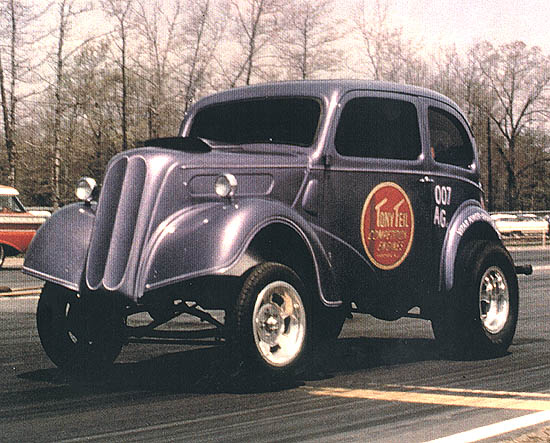
Engine meister Tony Feil ran this Chevy powered ’48 Anglia in A/Gas. Feil’s race cars were known for outstanding performance and appearance. Tony is an ECDT Hall of Fame member and regular at the annual HOF October gatherings in Henderson, NC.
To remedy these messy image issues early hot rodding organizers began political lobbying, to convince public officials to provide a place where hot rodders could safely race. NHRA’s founder, Wally Parks, was the master of such friendly persuasion. Wally’s lobbying convinced many communities to create local drag strips that ended street racing.
NHRA set up safety rules and they organized and policed the drag races. These efforts slowly changed the image of hot rodders and by the mid-1950’s drag racing began a slow, steady climb towards legitimacy. Many former street racers moved into the Gas Coupe and Sedan classes. From this came the race cars and racers that became icons of an era.
With the political/social background now explained, let’s examine the vehicles that were what really was a “Gasser”.
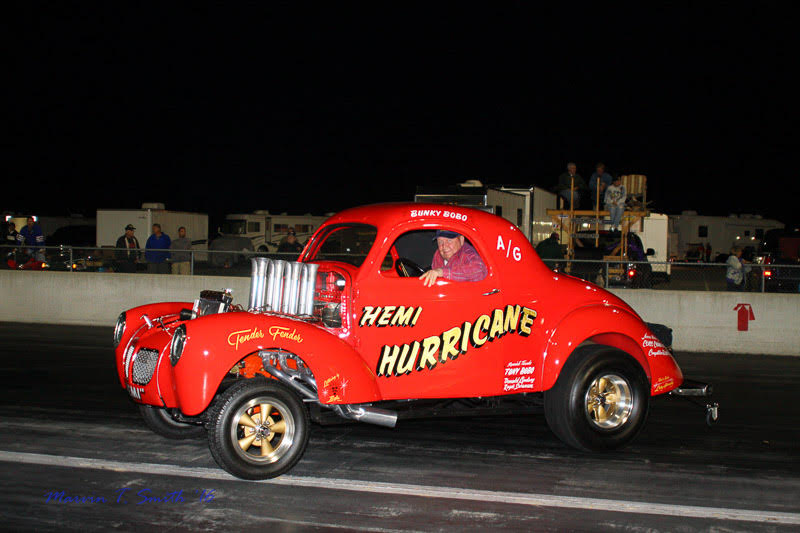
Lamar “Bunky” Bobo’s bright red ’40 Willys ran 426 Hemi power with long A/FX style injector stacks. Bunky’s “Hemi Hurricane” was restored by his son to its race day glory.
As usual, the best starting place is the cars. Among the most popular for early Gasser modification were the Fords, especially the Model A (1928-31) and the Model B, of which that classic American hot rod, the ’32 Ford “Deuce Coupe” are members. Also included were the 33-41 model years, and to a lesser degree, the “fat fendered” ’46-48 models. In those days Model A and B Fords were plentiful and cheap. A modern, overhead-valve V-8 was installed and often a rear axle strong enough to handle the increased HP, with gearing for quarter mile competition. With more improvements, the Gasser was born.

Hubert Platt ran this ’38 Chevy with small-block Chevy power from his brother, Huston Platt. Hubert later became a hugely successful Ford factory backed racer and east coast Ford Drag Clinic Team leader with Randy Payne.
By the late 50’s Gasser racing had smoothed itself into a seriously competitive sport. Smaller, more aerodynamic body styles led to the “classic look”. These included the Willys coupes and sedans, 1933 through 1941, post-WW-II Henry-J coupes, pre-War Chevys and pre-War Dodges and Plymouths. Pre-War Pontiacs, Oldsmobile’s and an occasional LaSalle or Buick were also seen. All fit handily into the Gasser classes with a well-built V-8 and enhancements such as fuel injection or multiple carburetors, four-speed manual transmissions, traction bars to control rear leaf-spring wrap-up, and a set of racing slicks.
Classifications were simple in the early days. A, B, C, D and E/Gas were reserved for overhead valve V-8’s. F/Gas was reserved for flathead V-8 or inline six-cylinder engines. Weight breaks for the OHV classes began at 7 lbs. per CID, for A/G. One pound per CID was added through E/Gas, which was 11 pounds.
By the end of both Gassers and their Modified Eliminator bracket (Modified began with Street Eliminator as its name) the class roster had ballooned to 14 separate Gas classes. These began with A/Gas, at 5.00-5.99 lbs. per CID to the last OHV V-8 class, H/Gas, at 12.00 lbs. per CID, and I through M/Gas, for inline six cylinder engines. Finally, there was N/Gas, exclusively for flathead V-8 and inline straight 8 flatheads. Super Modified, (added in the mid-1970’s with A-B-C classes), Street Roadsters, Stock Sports (A through E/SP) and Modified Sports cars also once competed in Modified.

Gene Altizer’s Chevy powered A/Gas Anglia was early S&S Racing Team member. Gene and the S&S team are all ECDT Hall of Fame members and regulars at the annual Hall of Fame Weekend in Henderson, NC.
What began as a fairly simple formula became stretched into “a class for every car”. Finally, NHRA claimed declining entry turn-out and dropped Modified Eliminator at the end of the 1981 season. In protest more than 150 cars showed up to compete for the 48 car field at the 1981 Nationals. A “protest parade” of over 100 Mod racers drove slowly down the main grandstands return road carrying signs that cried: “Save Modified”. NHRA’s honchos were unimpressed. Modified was deleted at the end of that season and its classes shuffled off to run in either Competition Eliminator or Super Stock. A few made the switch but more elected to bitterly quit racing.
“What goes around, comes around”, that well-worn cliché, has done just that. The continuing rise of nostalgia drag racing has brought back many of the graybeard racers and an enthusiastic new crop of fans and participants.
To understand the lure requires a cursory knowledge of what a typical Gasser was during their peak period of popularity, the 1960’s. Essentially, Gassers were “everyman’s race car”, leaving considerable room for interpretation.

Cleveland, Ohio’s Gene Schwartz was an Ohio Gasser standout in the 60’s with this ’52 Chevy Deluxe coupe. Schwartz, an internationally known blues guitarist, will be inducted into this year’s 2016 East Coast Drag Times Hall of Fame, October 14-16, in Henderson, NC. Gene built this replica car for nostalgia racing and loves doing wheelstands!
Probably the most populated classes were those where the weight break was 9, 10 or 11 pounds per CID. These classes were heavily filled with a variety of chassis and body styles, and most were powered by some sort of small-block Chevy. The fact that SBC power could range from 287 CID up to 350, or even 377-389 CID meant a Chevy might be found in nearly anything called a Gasser.
The upper Gas classes, that is, A/Gas (5.00-5.99 lbs., per CID), and B/Gas, (6.00-6.99) were where lightweight cars with moderate CID were most popular, and competitive. A small-block in a small, short-wheelbase chassis, such as a ’49 Anglia or Austin, could still be somewhat competitive in A and B/Gas against the 426 Hemi, the occasional 427 SOHC Ford, or a big-block Chevy. Still, it was tough to get an A or B/Gas chassis light enough to compete against a big-inch car.

Jim Zakia began running this ’55 Chevy in C/Gas, later a ’48 Anglia and then an Opel GT for A/Gas. Many times national A/Gas class champion and record holder, Zakia will be inducted into the ECDT Hall of Fame October 14-16, in Henderson, NC, and is bringing his fully restored A/G Opel GT for display!
More popular were the 9-10-11 pound classes, whose 283 to 350 CID engines could be built from those highly malleable building blocks, the 283 and 327 Chevy. A starting-point, junkyard 283 could be bought for under $50, complete. It came with a forged steel, 3.00” stroke crankshaft housed in a 3.875” bore, two-bolt main block. Bored .030”, the displacement rose to 288 CID, and with a .060” overbore came out at 292 CID. The two-bolt main cap 283 block cylinder walls retained sufficient material to prevent poor ring-seal due to wall flex.
Boring a 283 block (3.875” stock bore) .125” created the time-honored hot rodder’s favorite, the “301”. The trick to success with a 301 was to carefully choose a 283 block with minimal core shift, then bore it .125”, to 4.00”.
Chevy’s race-savvy engineers knew the 4.00” bore by 3.00” stroke combination was hugely efficient for making power, especially at high rpm. In 1967 they created the now legendary 302 CID Z-28 option, which nearly duplicated the original “301” but with a stronger, beefier 4.00” bore block that also boasted four-bolt main caps. Gasser racers knew a winner too, and they followed with .030” overboring (305 CID) and .060” overbore, (311 CID).

David Hales is another early S&S Parts Company team member. This D/Gas ’55 Chevy was feared in D and E/Gas class before Dave built his C/Gas ’40 Willys coupe.
By 1962 model year the 327 Chevy was the big news in Chevy’s line-up, and with the racers. The 327 offered that 4.00” bore, four-bolt main block in engine options all the way up to 365 hp, for Corvettes. Like the 283’s, the high performance 327 had a forged steel, 3.25” stroke crank, an excellent choice for its volumetric efficiency.
Proof lies in the 331 CID engines preferred by Bill Jenkins for his ’71 Vega small-block Pro-Stocker. Jenkins merely took a 327, treated it to a .030” clean-up bore and hone, for optimum ring-seal. Grumpy’s “secret” lay in a light chassis powered by an engine built for maximum volumetric efficiency. His 331 CID small-blocks made more power per CID than big-inch engines, and the lighter Vega moved the weight and mass forward quicker. Jenkins’ world-beating Vega’s proved just how true Newton’s theories were.

Harry Luzader’s classic ’32 Ford (that’s him behind the car, left!) is shown here waiting for tech inspection at the ’64 NHRA Nationals. Luzader ran C/Gas, D/Gas and D/Altered with the trusty ’32. Harry is to be inducted in the 2016 ECDT Hall of Fame, October 14-16, in Henderson, NC.
Gas and Modified Production racers had previously discovered this, and embraced the “light car, small engine” credo. At the other end were Gas/MP racers in the heavier, “lower” classes. They too played the engine efficiency game, but with a small CID engine powering a heavy chassis. Due to their favorable hp-per-CID ratio, these combinations were constantly being applied to 12 and 13 lbs. per CID, “lower” Gas and Mod-Prod classes, and with great success. With Street (Modified) Eliminator racing using National Record ET’s for handicapping, a slower, lower class car running on or under the record had an edge in leaving first on the green light. The higher classed car had to then play catch-up-and-pass. Many faster cars lost these match-up’s when the driver grew impatient and red-lighted (fouled out), or became distracted watching the rapidly disappearing slower car and was late off the starting line.
Such drag racing “gamesmanship” added much to the excitement of watching eliminations, especially when a higher classed car, such as an A/Gasser, took on a lower class car, such as an F/Gasser. There were no “dial-in” ET’s or “breakouts”, just flat-out, gear-banging, wheelstanding, high-revving drag racing.
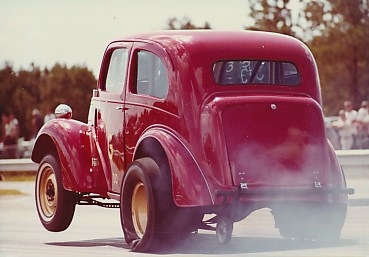
Robert Nance’s A/Gas ’48 Anglia picks ’em up at the NHRA World Championship Series Points Meet at Warner Robins Dragway, Warner Robins, GA, 1967. (Jim Hill photo)
NEXT WEEK PART 2: Heroes of the Gasser ranks and the 60’s “Gasser Wars”

